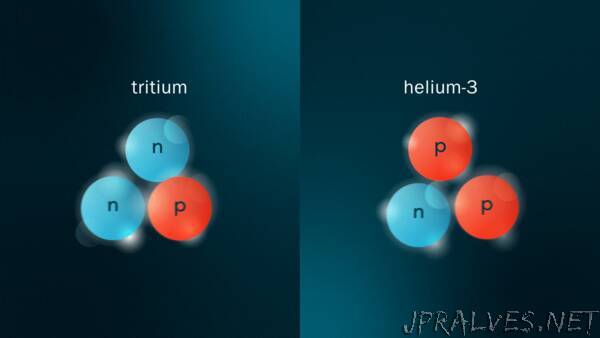
“The atomic nucleus is a busy place. Its constituent protons and neutrons occasionally collide, and briefly fly apart with high momentum before snapping back together like the two ends of a stretched rubber band. Using a new technique, physicists studying these energetic collisions in light nuclei found something surprising: protons collide with their fellow protons and neutrons with their fellow neutrons more often than expected.
The discovery was made by an international team of scientists that includes researchers from the Department of Energy’s Lawrence Berkeley National Laboratory (Berkeley Lab), using the Continuous Electron Beam Accelerator Facility at DOE’s Thomas Jefferson National Accelerator Facility (Jefferson Lab) in Virginia. It was reported in a paper published today in the journal Nature.
Understanding these collisions is important for interpreting data in a wide range of physics experiments studying elementary particles. It will also help physicists better understand the structure of neutron stars – collapsed cores of giant stars that are among the densest forms of matter in the universe.
John Arrington, a Berkeley Lab scientist, is one of four spokespersons for the collaboration, and Shujie Li, the lead author on the paper, is a Berkeley Lab postdoc. Both are in Berkeley Lab’s Nuclear Science Division.
Protons and neutrons, the particles that make up atomic nuclei, are collectively called nucleons. In previous experiments, physicists have studied energetic two-nucleon collisions in a handful of nuclei ranging from carbon (with 12 nucleons) to lead (with 208). The results were consistent: proton-neutron collisions made up almost 95% of all collisions, with proton-proton and neutron-neutron collisions accounting for the remaining 5%.
The new experiment at Jefferson Lab studied collisions in two “mirror nuclei” with three nucleons each, and found that proton-proton and neutron-neutron collisions were responsible for a much larger share of the total – roughly 20%. “We wanted to make a significantly more precise measurement, but we weren’t expecting it to be dramatically different,” said Arrington.
Using one collision to study another
Atomic nuclei are often depicted as tight clusters of protons and neutrons stuck together, but these nucleons are actually constantly orbiting each other. “It’s like the solar system but much more crowded,” said Arrington. In most nuclei, nucleons spend about 20% of their lives in high-momentum excited states resulting from two-nucleon collisions.
To study these collisions, physicists zap nuclei with beams of high-energy electrons. By measuring the energy and recoil angle of a scattered electron, they can infer how fast the nucleon it hit must have been moving. “It’s like the difference between bouncing a ping-pong ball off a moving windshield or a stationary windshield,” said Arrington. This enables them to pick out events in which an electron scattered off a high-momentum proton that recently collided with another nucleon.
In these electron-proton collisions, the incoming electron packs enough energy to knock the already excited proton out of the nucleus altogether. This breaks the rubber band-like interaction that normally reins in the excited nucleon pair, so the second nucleon escapes the nucleus as well.
In previous studies of two-body collisions, physicists focused on scattering events in which they detected the rebounding electron along with both ejected nucleons. By tagging all the particles, they could tally up the relative number of proton-proton pairs and proton-neutron pairs. But such “triple coincidence” events are relatively rare, and the analysis required careful accounting for additional interactions between nucleons that could distort the count.
Mirror nuclei boost precision
The authors of the new work found a way to establish the relative number of proton-proton and proton-neutron pairs without detecting the ejected nucleons. The trick was to measure scattering from two “mirror nuclei” with the same number of nucleons: tritium, a rare isotope of hydrogen with a single proton and two neutrons, and helium-3, which has two protons and a single neutron. Helium-3 looks just like tritium with protons and neutrons swapped, and this symmetry enabled physicists to distinguish collisions involving protons from those involving neutrons by comparing their two data sets.
The mirror nucleus effort got started after Jefferson Lab physicists made plans to develop a tritium gas cell for electron scattering experiments – the first such use of this rare and temperamental isotope in decades. Arrington and his collaborators saw a unique opportunity to study two-body collisions inside the nucleus in a new way.
The new experiment was able to gather much more data than previous experiments because the analysis didn’t require rare triple coincidence events. This enabled the team to improve on the precision of previous measurements by a factor of ten. They didn’t have reason to expect two-nucleon collisions would work differently in tritium and helium-3 than in heavier nuclei, so the results came as quite a surprise.
Strong force mysteries remain
The strong nuclear force is well-understood at the most fundamental level, where it governs subatomic particles called quarks and gluons. But despite these firm foundations, the interactions of composite particles like nucleons are very difficult to calculate. These details are important for analyzing data in high-energy experiments studying quarks, gluons, and other elementary particles like neutrinos. They’re also relevant to how nucleons interact in the extreme conditions that prevail in neutron stars.
Arrington has a guess as to what might be going on. The dominant scattering process inside nuclei only happens for proton-neutron pairs. But the importance of this process relative to other types of scattering that don’t distinguish protons from neutrons may depend on the average separation between nucleons, which tends to be larger in light nuclei like helium-3 than in heavier nuclei.
More measurements using other light nuclei will be required to test this hypothesis. “It’s clear helium-3 is different from the handful of heavy nuclei that were measured,” Arrington said. “Now we want to push for more precise measurements on other light nuclei to yield a definitive answer.”
The Continuous Electron Beam Accelerator Facility is a DOE Office of Science user facility.
This work was supported by the DOE Office of Science.”
